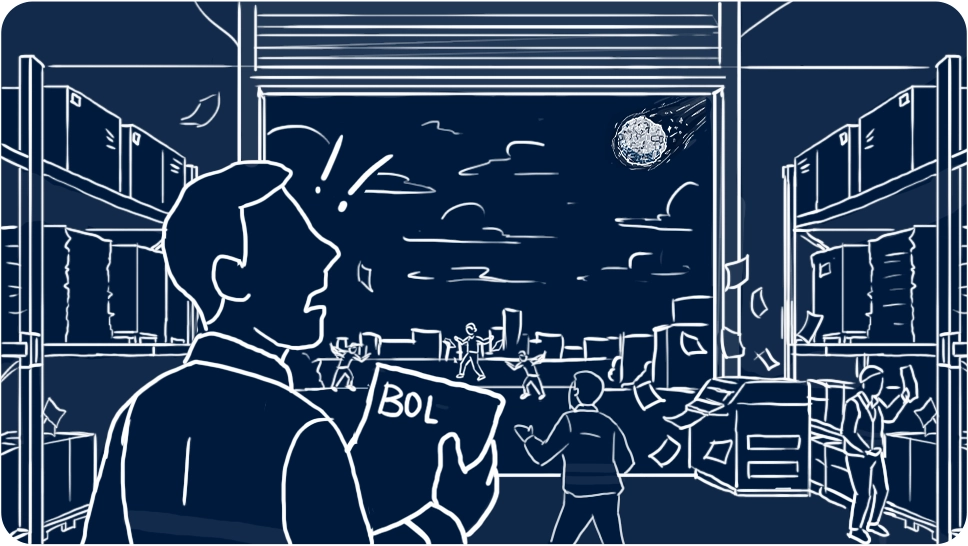Supply chain risk management used to focus on upstream disruptions: supplier delays, transportation bottlenecks, and geopolitical uncertainty. But as global supply chain operations have matured, an entirely different cause of supply chain disruption has surfaced at the store’s back door.
Store receiving remains one of modern retail logistics's last largely paper-driven processes. And that paper isn't just inefficient, it's risky.
The World Economic Forum recently noted, “As businesses move towards more digital operations, supply chain security becomes more important and more challenging. Addressing these challenges requires a holistic, risk-based and collaborative approach.”
Paper-based receiving creates exactly the blind spot modern supply chain leaders are trying to eliminate.

Store teams handle daily deliveries with thick paper packets: Bill of Ladings (BOLs), seal confirmations, return slips, and claims forms. This creates risk at every handoff:
- Delays at receiving doors while juggling paperwork.
- Seal mismatches confirmed verbally, not digitally.
- Missing signatures or incomplete forms surfacing days or weeks later.
- Manual reconciliation of received vs. allocated inventory.
- Claims filed but reversed due to missing documentation.
- 7+ day lags to retrieve delivery records for audits or compliance checks.
These gaps don’t just slow things down; they compound operational, financial, and compliance risk across the entire chain.
Store Receiving Is a Supply Chain Risk Factor
While most digitalization efforts target warehouses or transportation, few organizations focus on store receiving workflows as a critical risk vector in supply chain management:
- Inventory discrepancies ripple downstream into replenishment issues.
- Missing documentation delays billing and disrupts cash flow.
- Inaccurate deliveries fuel shrinkage and claim disputes.
- Audit gaps emerge when paper records are incomplete or inaccessible.
The store experience is often the weak link in otherwise sophisticated logistics operations, a gap that undermines supply chain resilience when overlooked.
Digitalizing Deliveries to Reduce Risk
Electronic Bill of Lading (eBOL) systems eliminate this paper problem at its source, transforming deliveries into real-time digital events:
- Pre-arrival notifications alert store teams before trucks arrive.
- Delivery manifests are digitally preloaded onto store devices such as PCs or tablets.
- Photo-based seal verification and barcode scans replace verbal checks.
- Digital signatures with timestamps create full audit trails at delivery.
- Instant document access across systems, with no paper chasing.
This shift delivers far more than efficiency; it gives supply chain professionals control, confidence, and real-time visibility.
The Broader ROI of Digitalizing Store Receiving
Beyond simply replacing paper, eBOL adoption creates a meaningful, measurable impact that supplements your existing digitalization and automation strategies:
- Modernizes supply chain operations with scalable automation and digital workflows. By replacing manual, paper-based processes, organizations gain the agility and infrastructure to scale efficiently, driving measurable ROI and supporting ESG goals through reduced waste and improved sustainability.
- Reduces operational and compliance risk with end-to-end visibility, full traceability, and precise process control. Digital workflows and real-time oversight minimize errors, streamline audits, and enable proactive risk mitigation, improving regulatory alignment and supporting sustainability-driven accountability.
- Enables faster, data-driven decisions by delivering real-time access to clean, verifiable operational data. With unified insights across distribution, warehousing, and logistics, leaders can identify bottlenecks, respond to issues quickly, and drive continuous improvement, translating directly to financial performance and ESG transparency.
- Unlocks workforce efficiency by eliminating manual tasks and streamlining redundant workflows. Teams are freed to focus on higher-value activities, improving productivity while reducing overhead and labor costs, resulting in operational ROI and a leaner, more sustainable supply chain.
The financial and operational gains extend well beyond the dock door. BOL digitalization and automation extend the impact of your existing digital strategies—delivering enterprise-wide ROI, greater operational resilience, and a future-ready supply chain built for sustained efficiency and competitive advantage.
Paper Isn’t Just Inefficient, It’s Risky
As long as paper drives store receiving, unseen risks continue to build: compliance gaps, financial leakage, and operational delays.
Digitalizing delivery documentation at store receiving is no longer a nice-to-have; it's a supply chain risk management priority. For companies committed to operational control, financial health, supply chain resilience, and customer experience, it’s one of the fastest paths to de-risking the entire supply chain.
The next mile of supply chain improvement starts where the truck meets the store.
If you're ready to transform delivery receiving into a real-time, risk-reducing digital process, driverDOC Pulse can help. Book a demo with our team to learn how our supply chain risk management solutions can help you mitigate risk.
Table of Contents
Latest Articles
Bridging the Gaps in Freight: Why eBOL Is the New Standard for Supply Chain Regulatory Compliance
In today’s hyper-connected, high-stakes supply chain landscape, the traditional paper Bill of Lading (BOL) is no longer just outdated—it’s a security and compliance liability.
MoreCompliance in Supply Chain Management: Why Retailers & Suppliers Are Struggling
Compliance in supply chain management is breaking down as paper-based documentation fuels fraud, chargebacks, and lost cargo. Learn how digital solutions close the gaps.
MoreWhat is the Electronic Bill of Lading? eBOLs are the Foundation to Preventing Supply Chain Fraud
Learn what an electronic Bill of Lading (eBOL) is, how it eliminates paper inefficiencies, prevents fraud, and improves supply chain transparency.
MoreTake the First Step to Transforming Your Supply Chain Management


